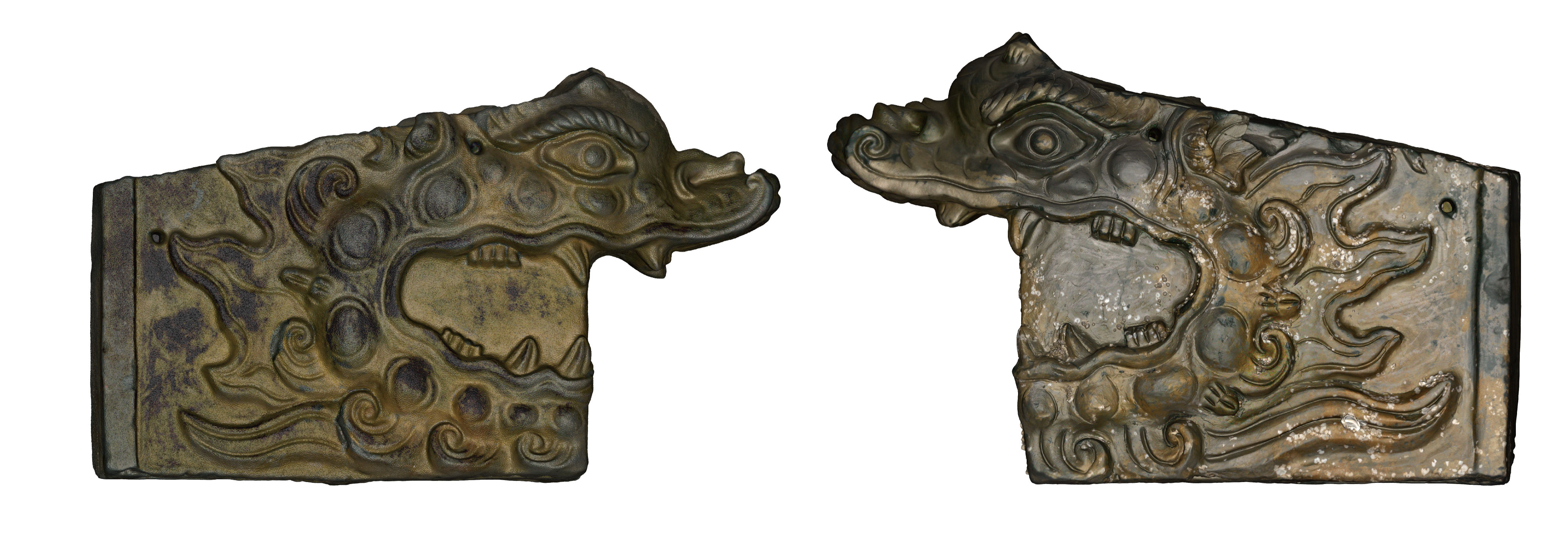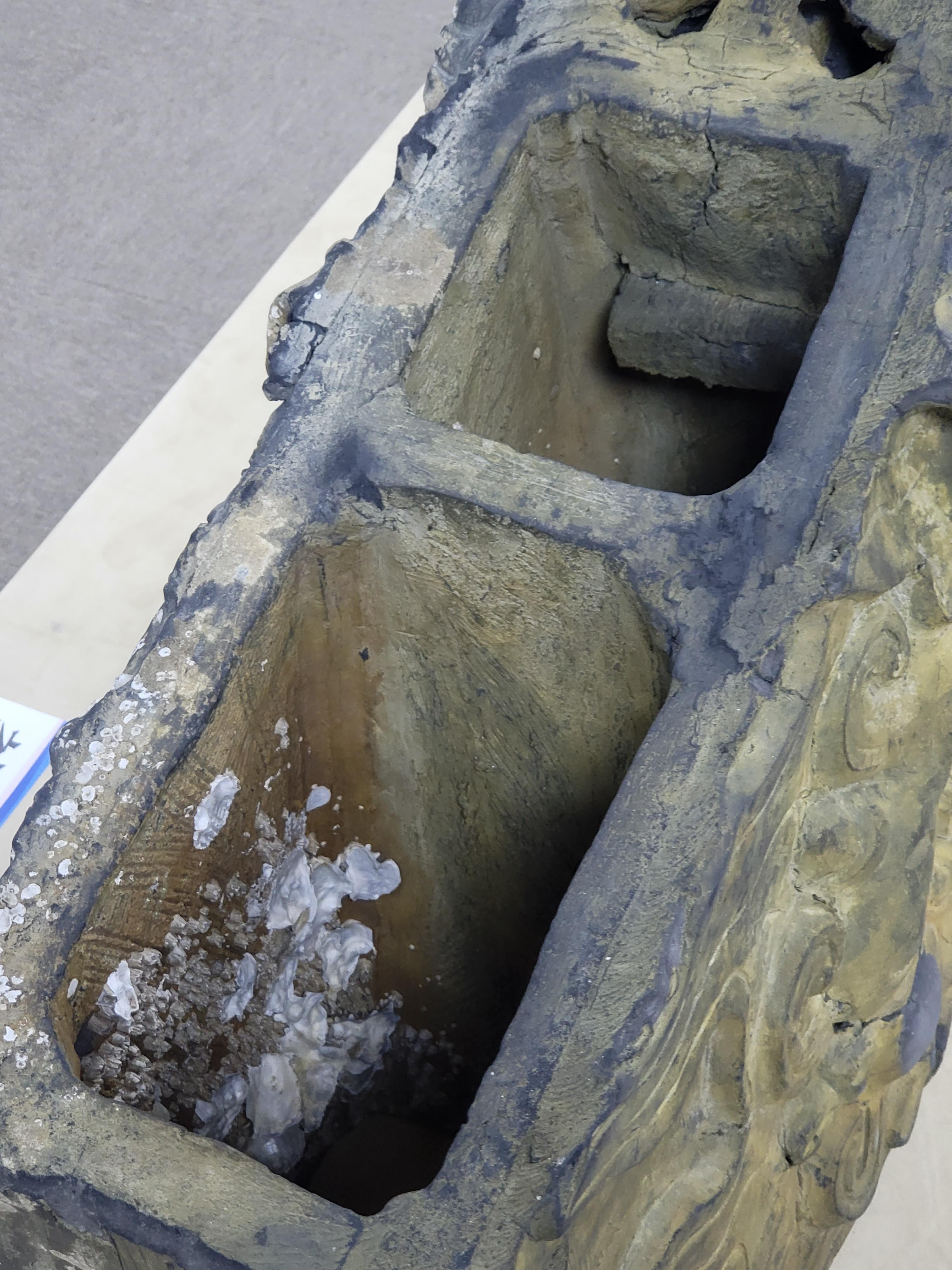
Found the original shape of the dragon-headed ornamental roof tiles related to the royal buildings early in the Joseon Dynasty
- The National Research Institute of Maritime Cultural Heritage discovered additionally from the mudflats of Cheongpodae, Taean, Chungnam Province, Korea -
The National Research Institute of Maritime Cultural Heritage(Director, Kim YeonSoo) affiliated to Cultural Heritage Administration which surveys the proximities of the mudflats at Cheongpodae, Yangjam-ri, Taean newly discovered at the last May the upper part of the dragon-headed ornamental roof tile (Chuidu(鷲頭)) and the hilt shaped ornament, Geompa(劍把).
On 29th June, 2022, they will be released firstly to the press at the National Palace Museum of Korea (Located at Jongno-gu, Seoul City).

* Chuidu(鷲頭) : Large ornamental roof tiles to be installed at the both ends of the ridge of the roof on the royal buildings such as the palace
* Geompa(劍把) : Hilt shaped clay-made ornament stabbed on the top of the Chuidu
The upper part of the ornamental roof tile and Geompa excavated at this time are artifacts to be assembled at the lower part of the roof tile which had been discovered and reported on 2019 during collecting the shells by a resident.
It was confirmed that these were pairing with the ornamental roof tile (Upper and lower part) excavated during June 2021 by the NRIMCH.

The whole shape of the dragon-headed ornamental roof tile became to assure firstly as the intact shaped Chuidu to be mounted on the ridge of the roof owing to discovering the Geompa.
In addition, it is very meaningful in respect of acquiring the material data for the studies on the ornamental roof tiles related to the royal families of Joseon Dynasty.




Especially, these are evaluated as unique archeological data for historical evidencing on the details of the royal buildings of the early Joseon Dynasty such as the building written at the records on establishing Gyeongbokgung Palace, Sungryemun Gate, Yangju Hoeamsa Temple Site and etc.

* Ornamental roof tile : A specially made roof tile to guard the building or stand out the dignity and aesthetics by using on top of the ridge of the roof of wooden building
* Yangju Hoeamsa Temple : The largest and representative royal Buddhist temple in Korea from the late Goryeo to the mid-Joseon Dynasty
The Geompa excavated on May 2022 is hilt shaped in 40.5cm x 16cm x 7cm. The cloud patterns in two rows are expressed at the both sides and it has a short hold to be fit to the square hole on the top of the Chuidu.
The Geompa was used practically to block the rainfall flowing into the Chuidu, and it is delivered that the biting of the dragon engraved on the Chuidu has the meaning of blocking the gnawing the ridge of the roof.





The cloud patterned Geompa excavated at this time is differed in its shape from the pattern-less simple rod type Geompa found from some dragon-headed roof tiles on the roofs of the palaces of the latter half of Joseon Dynasty, such as the Injungmun Gate at Changdukgung Palace.
* Changdukgung Palace : The central palace of the late Joseon Dynasty, whose original form is the best
preserved well compared to other remaining Joseon palaces
The National Research Institute of Maritime Cultural Heritage of the Cultural Heritage Administration has a plan to examine the related artifacts till the mid of August through additional excavating and underwater investigation.



Moreover, the in-depth study will continue on the existence of the old ships at the seas where the Chuidu has been excavated, the production and distribution of the ornamental roof tiles to the local areas.
'NEWS & THESIS' 카테고리의 다른 글
| Original Soundtrack Album of “Kiss Sixth Sense” Starring Yoon Kye-sang and Seo Ji-hye (1) | 2022.07.02 |
|---|---|
| 홍낭시다, 한국이 처음으로 판 해외 힌두사원 (0) | 2022.07.01 |
| 태안 갯벌에서 건진 조선전기 궁궐 장식기와 (1) | 2022.06.29 |
| 구미 황상동 고분군을 깠더니... (0) | 2022.06.26 |
| 독서당계회도 언론공개 현장을 둘러보고 (1) | 2022.06.22 |




댓글